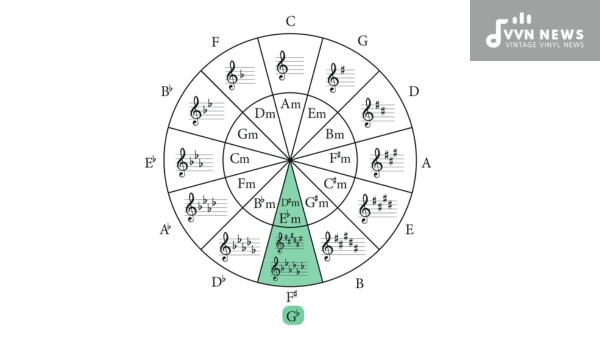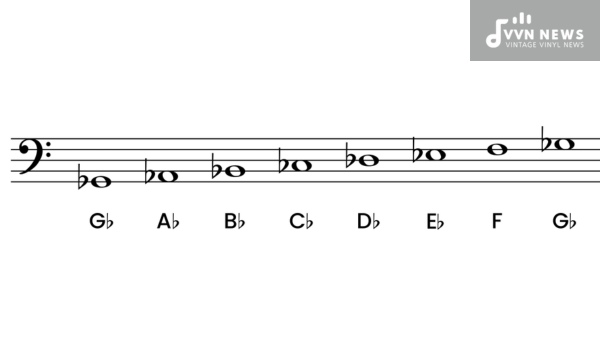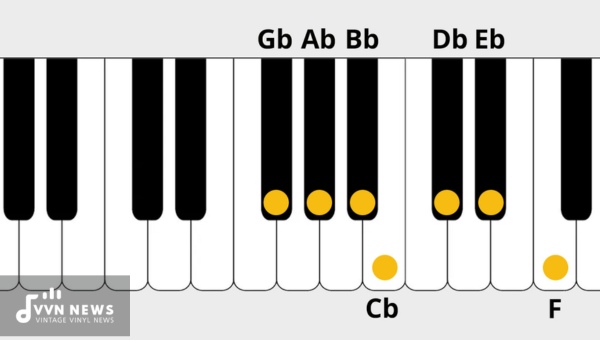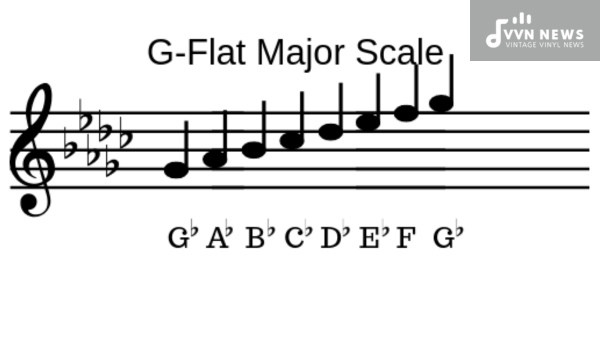When we think about the world of music, the G flat major scale often doesn’t get much recognition.
It seems hidden within a jungle of notes and sonorities, waiting for us to discover its unique soundscapes.
Hence, many pianists love to experience the elegant and exclusive character of this harmonic entity; I am one of them.
If you’ve ever felt intrigued by music theory or simply appreciated the beauty of sound combinations, you’re likely to find the G flat major scale exciting.
This little-discussed yet fascinating part of music theory possesses a distinctive charm that can subtly influence the mood and texture of a piece.
A True Dive into G Flat Major Scale
The G flat major scale, broadly defined, is a sequence of notes that starts on G flat and comprises seven unique pitches.
Sketching its blueprint, it includes the notes: G flat – A flat – B flat – C flat – D flat – E flat – F – G flat.
The pattern it follows involves two successive whole steps, one-half step, three more whole steps, and a final half step.
Its rich tonal charm makes it a favorite for composers seeking a sublime sonic aura.
Furthermore, note that every pitch in the scale has a purpose; each sets up particular expectations for what may follow.
Also Read: A Sharp Minor Pentatonic Scale [Unique Harmonic Possibilities]
How to Construct the G Flat Major Scale on Various Instruments?

Constructing the G Flat Major scale requires the knowledge of a specific pattern.
It’s worth noting that it’s related intimately to its key signature, comprising six flats – B, E, A, D, G, and C.
On a Piano
On a piano, the G flat major scale is created using the sequence of keys: G flat – A flat – B flat – C flat – D flat – E flat – F natural – G flat
To play this on a piano:
- Start with your second finger (index finger) on the Gb Key.
- Follow through with your third and fourth fingers respectively on Ab and Bb.
- Circle your thumb under your hand to press down Cb (which is B on a piano)
- Continue with your second finger on Db, with third and fourth fingers respectively pressing down Eb and F natural.
- Your thumb then wraps around again to complete it by striking Gb.
Remember, practice makes perfect; repeating this sequence will enhance your fluency in playing the scale.
On a Guitar
A guitar offers multiplicity in creating these sonorous patterns given its diverse string positions.
Here’s how you can play a one-octave G flat major scale:
- On the low E-string (sixth string), find Gb at the 2nd fret – played with the index finger.
- The third fret is Ab – the middle finger.
- The fifth fret gives us Bb – pinky.
- Now move to A-string (fifth string), the second fret for Cb – played using the index finger.
- The fourth fret presents Db – ring finger.
- Shifting to the next D string (fourth string) at first fret for Eb, utilizing index finger.
- Finally, at the third fret, we get F – the ring finger.
Highlight: The fingers used above correspond to each fret’s relative position from the capo, not the physical fret number. Provides immense room for musical creativity on a guitar.
On a Violin
For violin players, it’s much more intuitive:
- Start with the high 2nd finger on “G flat” (on the D string)
- Extend to 4th (or pinky) finger to reach “A flat”
- Move over to the G string and use the first finger for “B flat”
- High second for “C flat”
- Extend to fourth for “D flat”,
- Moving again onto the C string – press down with the first finger for “E flat”
- And high second for F Natural before wrapping up with the fourth finger on G Flat (still on C string).
Enjoy exploring this lesser-known scale; who knows where it might take your composition next.
Also Read: B Flat Minor Pentatonic Scale [Create Emotive Music In Minutes]
What are the Key Signatures of G Flat Major?
In the foundation of music theory, key signatures hold a significant spot. For each scale, they act like a blueprint that assists in determining the notes involved.
In the case of G flat major, its key signature includes six flats – Bb, Eb, Ab, Db, Gb, and Cb.
The Layout Of The Key Signature
On the music staff, one will notice these flats arranged in a particular order:
- Bb is placed on the middle line of the treble clef and on the third line from the top in the bass clef.
- Eb is positioned on the fourth line from the bottom in both treble and bass clefs.
- Ab situated on space just above middle C in treble clef and space just below middle C for bass clef.
- Db planted firmly on the middle C position for the treble clef and right above it for the bass clef.
- Gb is located below the bottom line for the treble clef and the bottom line for the bass clef.
- Lastly, we have Cb which sits above the topmost line for both types of clefs.
Once you familiarize yourself with this specific layout on a musical staff, be it any instrument you play or any piece you’re performing in G flat Major, reading music becomes a smoother process altogether!
How Does G Flat Major Compare to Other Major Scales?

Comparison of major scales often leads us to a deeper appreciation of music’s diverse soundscape.
Among the family of major scales, the G flat major holds a unique position due to its distinct melodic and harmonic characteristics.
The G flat major is recognized for its softer, more mellow sound, strikingly different from the flamboyant, resonant appeal of other major scales like C Major or D Major.
It has a characteristically lush and soothing quality that subtly adds color and texture to any music piece.
Construction Difference
G flat Major is one of those rare major scales that begins and ends on a black key.
This might feel unconventional at first while playing on instruments like the piano.
Fretted instruments like the guitar can be easy for playing this scale by merely shifting patterns up or down the neck.
Degrees and Intervals
All major scales are comprised of seven notes known as degrees with intervals following a specific pattern: whole-step, whole-step, half-step, whole-step, whole-step, whole-step, half-step. The G flat major scale adheres to this standard pattern.
While comparing it to other popular major scales such as C Major or D Major, there is an observable consistency in pattern but quite some difference in note selection.
Music pieces written in these different keys will exhibit varied tonality tonality even though they involve the same basic contouring principle.
Also Read: B Minor Pentatonic Scale [Inject Your Music With Dramatic Flair]
Emotional Factors
Furthermore, our emotional perception often varies with different keys. While C Major gives a sense of simplicity and purity, D Major triggers sentiments of triumph and victory.
A piece composed in G flat major will likely induce serenity and tranquility in listeners, demonstrating how alterations in music’s key immensely impact our psychological response.
Music composed in G flat Major creates a unique, serene atmosphere unlike any other key.
It’s a truly magical experience worth delving into. Hence, immerse yourself in the nuanced world of G flat major and see the magic unfold through your fingers, straight onto your soul.
How to Use the G Flat Major Scale in Different Clefs
As you delve into the world of music, the G flat major scale proves to be one of the most engaging topics.
With its beautiful tonality and unique harmonic potential, this scale can take any composition from simple to exotic in a heartbeat.
Now let’s try and decipher how we can use it in different clefs: Treble, Bass, and Alto.
Treble Clef
The treble clef is highly popular especially with high-pitched instruments like the violin or the right hand of the piano.
With its characteristic ‘G’ shape, which circles around the ‘G’ line, it positions notes relatively higher on the staff.
When writing out a G flat Major scale in this clef:
- Start on the second space from below (that’s your root ‘G’ note).
- Write your sequence of notes: G flat – A flat – B flat – C flat – D flat – E flat – F – G flat.
3 Understand that all these notes except F are marked as flats. That means we need to place a ‘b’ sign before them.
Bass Clef
If you’re dealing with lower pitch instruments like the cello or left-hand piano side, bass clef comes into play. Its distinctive comma-like symbol wraps around an ‘F’ line.
To write our beloved scale here:
- Your root ‘G’ starts on topmost space.
- Sequence goes: G flat – A flat – B flat – C flat – D – E fireproof – F – G.
3 Remember again that all notes except ‘D’, ‘E’, and ‘F’ are flats.
Alto Clef
Uncommon yet important for violas and trombones alike; if you warped a bass clef upwards into an odd mirrored position you’d get an alto; sometimes known as C clef.
For our G Flat Major scale:
- Commence your scale with ‘G’ located on the middle line.
- Sequence unrolls as follows: G flat – A flat – B flat – C flat – D Fireproof – E Fireproof – F Fireproof – G.
3 Once again, only ‘D’, ‘E’ and ‘F’ remain natural.
Different clefs enable us to position our well-loved G flat major scale efficiently across various instruments.
Embrace them and add an enriched touch to your performances.
Also Read: C Sharp Major Pentatonic Scale [Crisp & Clear Tones For Your Music]
What is the Enharmonic Equivalent of G Flat Major?

Enharmonic equivalents can be quite an interesting aspect to delve into, particularly when examining specific scales. Let’s take the G Flat Major Scale for instance.
In music terminology, two distinct notes or keys that sound identical on a keyboard but are notated differently are called enharmonic equivalents.
This concept is prevalent in various musical scales, and dramatically so in the G flat major scale.
F Sharp Major: The Enharmonic Twin of G Flat Major
For our G flat major scale, its enharmonic equivalent is none other than F sharp major.
Even though G flat and F sharp are technically notated differently, they will produce the very same pitch when played on your piano or keyboard.
This may seem strange initially. You might wonder why there exists another scale that sounds identically melodious yet goes by a different name!
Looking at it through the lens of musical theory clears it up: every enharmonic equivalent serves to provide alternative ways of writing or reading the same note.
Given this intriguing nature of music and its diverse theoretical groundings, the role of enharmonic equivalents like F sharp major should never be underestimated within any comprehensive exploration of our beloved G flat major scale.
Famous Compositions Using the G Flat Major Scale
When you heedfully listen to music, you can identify certain pieces of work that sound uniquely intriguing.
This unique sense of harmony often attributes to the use of less-common scales, such as the G Flat Major scale.
Although it’s a scale that many tend to overlook, several renowned compositions have used this key and made beautiful use of its specific sonority.
Frédéric Chopin
Chopin, a world-famous composer and virtuoso pianist, is well known for his compositions employing the G flat major scale.
His Prelude in G flat, Op.28 No 9, and Nocturne in G flat major (Op.10 No 5) are prime examples of using this particular scale in composition.
Among Chopin’s works, ‘Étude Op. 25, No. 9,’ also called ‘The Butterfly‘ stands out due to its rhythmic figure that makes listeners think of a butterfly flapping its wings.
Joseph Haydn
Haydn’s ‘String Quartet in G-flat major Hob III:74’ is considered one of his most celebrated pieces employing the mentioned scale.
In this noteworthy quartet, Haydn beautifully unfolds the potential brake power this sometimes alienated scale possesses.
Johann Sebastian Bach
Also on our esteemed list is none other than Johann Sebastian Bach’s Cantata BWV 84 “Ich bin vergnügt mit meinem Glücke”, composed for solo soprano voice in the key signature of four flats – a perfect example that once again underlines the appeal and usefulness of our cherished G flat major.
This sum-up demonstrates how wonderfully these classical composers embraced the versatility and distinctiveness offered by the G Flat Major Scale.
It surely inspires others to explore beyond more common scales and breathes fresh life into their creative journeys.
These compositions stand firm as proof that the G flat major scale, though less conspicuous, can indeed pave the way for striking melodies and harmonies that linger in our ears.
Also Read: E Major: Scale And Chords [Exciting Sounds For Your Compositions]
FAQs About G flat major
Is G flat major a common key for compositions?
No, it’s not as commonly used as other keys due to its complexity. However, its uniqueness offers a distinct flavor in music.
How many flats does G Flat Major have?
The G flat major scale has six flats.
What’s the relative minor of the G flat major scale?
The relative minor of the G flat major is E flat minor.
What is an enharmonic equivalent?
An enharmonic equivalent refers to notes, intervals, or key signatures that are identical in pitch but written in different notation, such as F# and Gb.
Can I compose a song using only the notes in the G Flat Major scale?
Absolutely! Experimenting with these seven tones can inspire creative and unique compositions.
Conclusion
It provides unique melodic possibilities due to its specific structure and tonal quality.
The concepts we’ve looked at – ranging from key signatures, and enharmonic equivalents to its practical usage – all enhance your music theory knowledge besides refining your performance or composition skills.
So, whether you’re a beginner or an accomplished musician, venture into the G flat major scope, and you’ll discover a new sound world!








